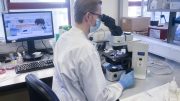Pathology is one of the most critical elements of accurate medical diagnosis, but it’s also one of the more time-consuming processes.
Interpreting tissue samples or bodily fluid slides can take weeks, for instance, because the process is dependent on the manual examination of specimens under a physical microscope.
Delays are further compounded because work must be done at a specific hospital or lab, where the shortage of pathologists to review the slides can cause backlogs and lead to case outsourcing. The pathologist shortage and the limitations of location-based working and their impact on overall productivity were made evident during the recent lockdown, especially at healthcare organisations with labs that were not digitised. Labs in which pathologists were unable to work remotely were at an obvious and significant disadvantage. This has thrown a spotlight on the necessity of digitisation in pathology, as in so many other areas of healthcare, not just for continuity and resilience in the event of any future work disruptions, but as a way to help pathology professionals maximise the effectiveness and quality of their work. The ability to view slide images from any location leads to much more efficient use of time, which is then reflected in faster and more accurate diagnoses.
Superior performance
At an organisational level, having a web-based platform that requires no software installation or the creation of copies of images for synchronisation vastly improves speed and workflow. This leads to better all-round lifecycle management, coupled with much-improved analytics and reporting that feeds into superior laboratory performance overall.
There is also the potential for major cost savings, since work is being done in a digital environment, greatly reducing the use of glass slides, coverslips, adhesives, and dyes, which can add up to a significant cost for laboratories.
Synced to workflow requirements
Of course, to be effective, any digital pathology solution must, at its core, be able to provide not just the highest quality experience in terms of image interpretation and workflow management , but also enable laboratories to better overcome the challenges often associated with traditional techniques.
For example, given that pathology images are usually several times larger than typical radiology studies, it’s imperative the system can retrieve and archive what are inherently larger datasets with minimum delay or interruption. Consider pathology solutions where there is no requirement to wait for the whole file to load before starting to review a study.
Accuracy of course is key when it comes to reviewing an image, which means that pathology professionals should expect the highest resolution image with great clarity and exceptional contrast from their ‘virtual microscope’. So, labs should be looking for viewers that support whole slide imaging (WSI) of eight megapixel or higher.
More effective diagnosis
Being able to view pathology images side by side or along with other imaging studies, provides an exceptional degree of flexibility, which can often lead to more effective diagnosis. Of course, to offer the best possible results, the system must be able to support all major standard healthcare APIs — such as DICOM, XDS, HL7 and FHIR — so it can deal with the widest range of image formats.
When you must switch between multiple digital systems because data is ‘siloed’ in other software applications, time and complexity are unnecessarily added to the process. Therefore, to maximise productivity gains, a lab manager should look for the highest level of connectivity between systems. A sound starting point is to implement a platform that is built around the open standard DICOM for Pathology (Supplement 145), which means it can integrate seamlessly with laboratory information systems (LIS/LIMS) and pathology quantitative solutions, as well as EMRs.
Future-proofed customisation
This also helps future proof the solution. Since the lab won’t be locked into a proprietary infrastructure, they instead have a system that allows self-governance, without the limitations of vendor-specific technologies, which could disrupt the import, export or management of data or the availability of future technology.
With a high degree of interoperability, a solution can meet the requirements of current workflows, while offering the modularity to customise the system to continue to meet them in the future. Being able to add resources without having to modify interfaces with third-party systems also provides great levels of scalability.
And because a system based on industry standards is device and browser agnostic, it’s possible for a pathologist to have that same level of continued connectivity from many locations. This also ensures that you can create what is truly an enterprise-wide solution that allows for multiple types of users, each with role-based access.
The way forward
Healthcare providers must innovate to survive, embracing the potential for technology to improve services and outcomes. Nowhere is this transformation more crucial than in pathology departments.
So, for any laboratory or hospital looking not just to maximise their productivity but also the accuracy of its pathology team, introducing a digital solution is the obvious, and in fact, the only way forward.
Alexander Ryan is the Healthcare Alliances and Net New Sales manager for EMEA with Hyland Healthcare. www.hyland.com





